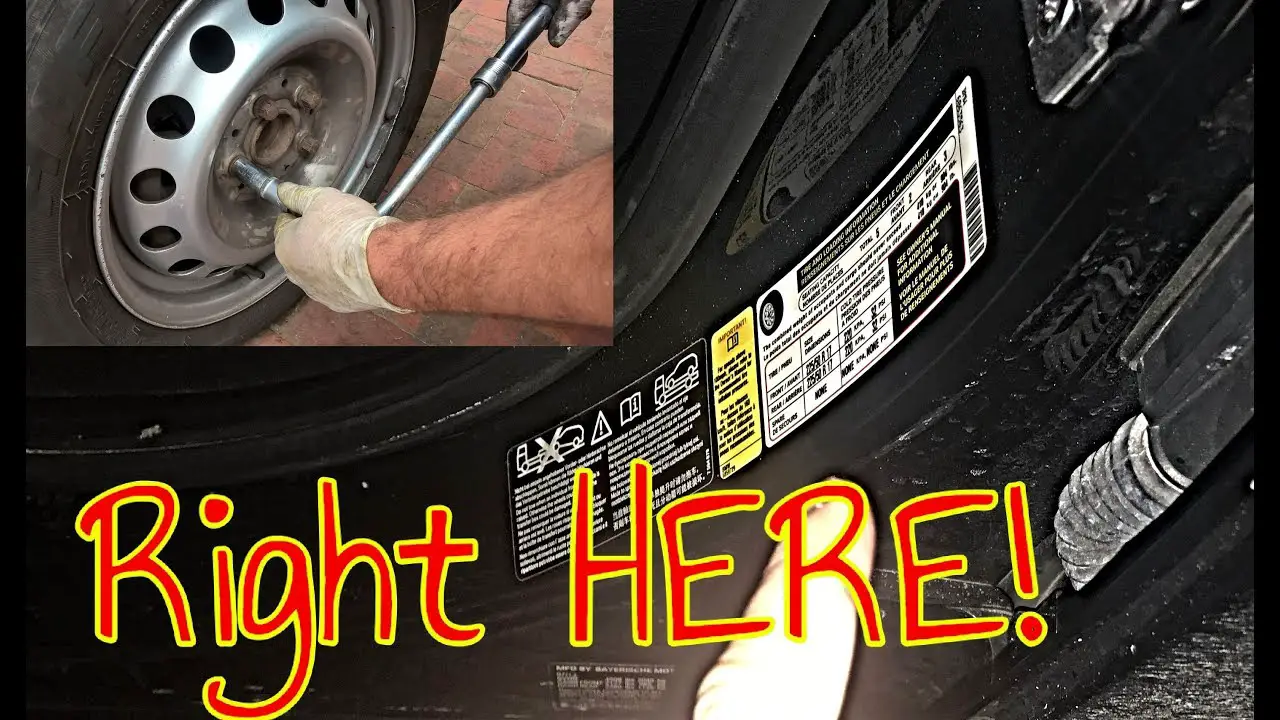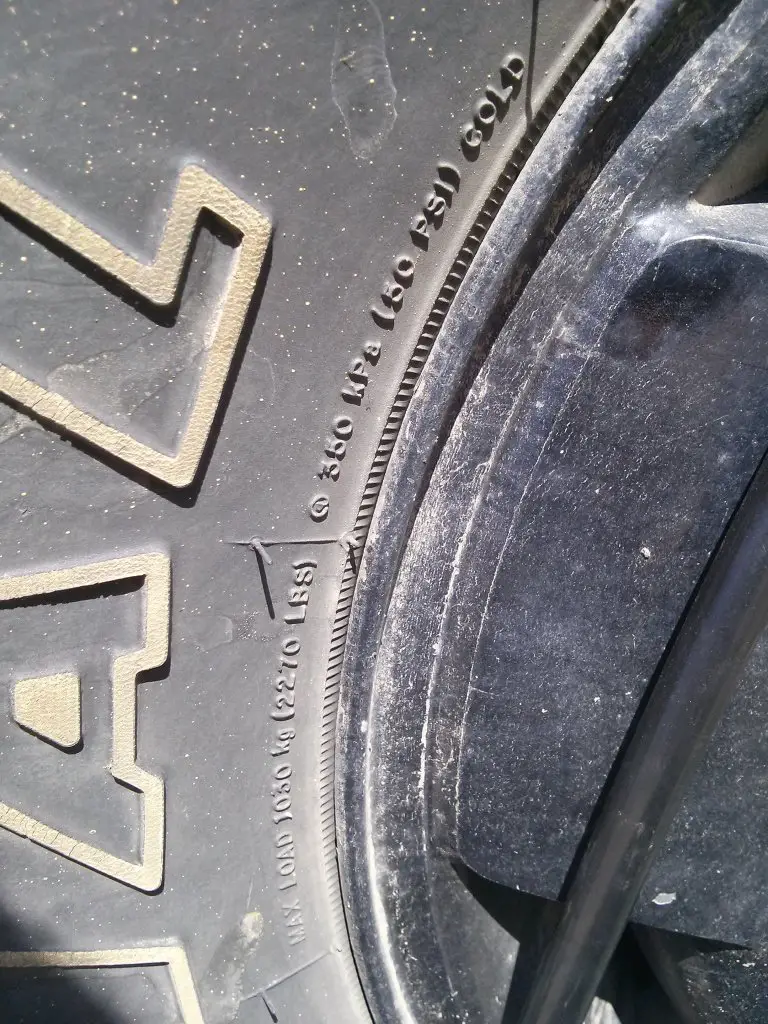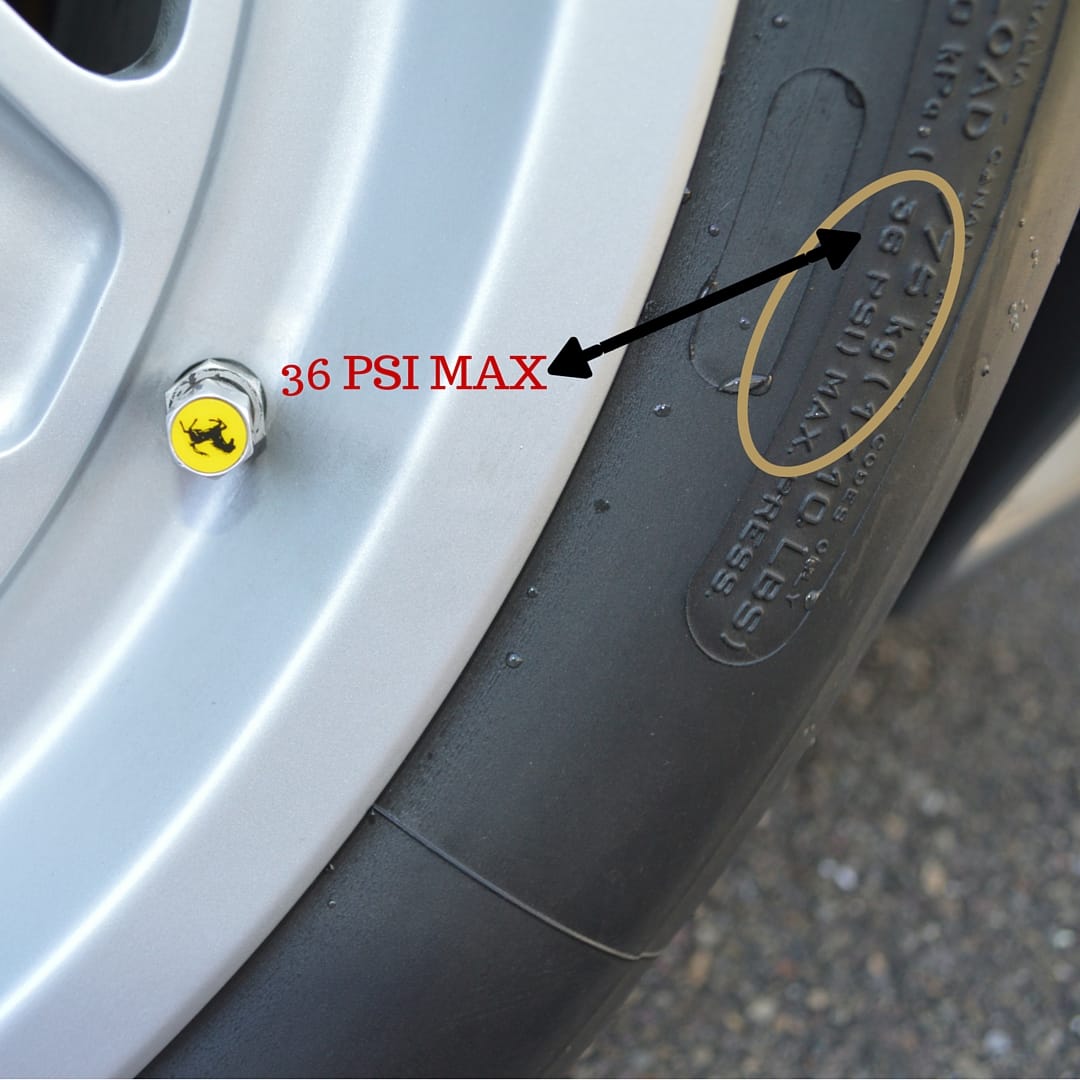Air Pressure/load Adjustment For High Speed Driving
psi lbs. 100 160 0 0 100% 35 1000 106 170 1 0.06 100% 36 1000 112 180 2 0.12 100% 37 1000 118 190 3 0.18 100% 38 1000 Note: Never exceed the maximum cold inflation pressure branded on the tire’s sidewall. More Speed Rating Charts * R-Speed Rated Tires * S-Speed Rated Tires * U-Speed Rated Tires *
Checking Tire Pressure In Cold Weather
Check your tires when your car has been parked for at least three hours. Your cars ideal tire pressure is usually listed inside the driver-side door. Be sure to check the recommended pressure for the front and rear tires in case theyre different.
Insert a pressure gauge into the tire air valve swiftly and firmly for an accurate reading. Then immediately replace the air valve cap to avoid letting out any air. If your tires are below the recommendation for your car, use an air compressor to inflate them until you get the right reading.
Its best to check your tires once a month, but you might need to check your tire pressure more often in cold weather. Other signs that your tires might be underinflated: They look flatter than usual the steering wheel shakes or it takes longer to come to a stop when braking.
Why Winter Tire Pressure Is Different Than Summer Tire Pressure
There are several misguided beliefs about the appropriate winter tire pressure that can result in costly problems for your car. In order to function properly and avoid problems, tires need to be appropriately filled to the correct pressure year-round. Why? Because weather conditions have an effect on tire pressure. For instance, during the summer months, the air expands in the tires as the weather heats up. During winters frigid months, the air pressure contracts. Something else to remember is that as you drive your vehicle, tire pressure increases slightly.
Read Also: Florida Dmv Duplicate Title Application
What Should Tire Pressure Be In Summer
As winter, then spring ends, a lot of drivers start asking what should tire pressure be in summer?
The best and short answer is that: Maintain the optimal tire pressure recommended by the manufacturer. Remember, the optimal pressure for your tire is NOT the same as the maximum tire pressure that can be put into your tires! If you do that, you might get the surprise of your life, when your tire explodes on a hot summer day if you drive for long stretches!
image credit: State Farm
Pay attention to your dashboard light indicators. If the low tire pressure indicator lights up, then one of your tires pressure has dropped. Better visit a gas station with air service to increase the pressure.
Theres one problem, though. What if your tires are overinflated? Theres no light indicator for that. If you have one of the newer cars with state of the art dashboard screen, it will show the pressure for every single tire, including your reserve. So overinflation isnt a problem for drivers of these newer cars.
Tire Specs Explained: Maximum Inflation Pressure

the tire in kilopascals and pounds per square inch . These values can also be found in the industry’s tire load & inflation charts. Related Links * Tire Specs Explained: Measuring Rim Width * Tire Specs Explained: Overall Diameter * Tire Specs Explained: Revolutions Per Mile * Tire Specs
Recommended Reading: How To Clean Dirty Leather Car Seats
Why Did My Tire Pressure Light Go On
Many newer cars come standard with built-in tire pressure monitors. Theyre linked to a dashboard light that alerts you if your tire pressure is incorrect its usually yellow or orange and looks like a cross-section of a tire with an exclamation point or the letters TPMS, which stands for Tire Pressure Monitoring System. Sometimes the car will have a tire pressure menu that allows you to view a readout of each tires current psi.
If your tire pressure light comes on, take it seriously. Sometimes it flickers or turns on briefly and then turns off other times it flashes repeatedly or stays on. No matter what the light does, you should check your tire pressure immediately .
The flickering or brief illumination could be as simple as a change in pressure due to temperature or an imperfection in the road. Flashing sometimes indicates that the sensor or the sensors battery needs replacing. If the light stays on solid for a time, theres a good chance you have a tire pressure issue. If you check the pressure and its fine, you may have a failing sensor, and you should get it replaced as soon as is practical.
Learn more about your tire pressure light.
Ideal Tire Pressure: What Should My Tyre Pressure Be
The reason why your steering wheel is acting up or being sluggish or why the gas mileage is unusually low or when you feel like your vehicle is closer to the ground than expected, is that you might be dealing with over inflation. Under inflating your car, on the other hand, is also not advisable. It affects the tires negatively causing them to wear, and makes the vehicle underperform.
The recommended pressure for most passenger cars tires when they are cold is about 32 psi to 35 psi.
It is advisable to check the tire pressure when they are cold. The reason for this is that, as they hit the road, the tires will generate heat because of the friction between them and the road.
This friction leads to an increase in temperature and air pressure. To get the correct reading with your tire pressure, the car must have been parked for a few hours or overnight.
To ensure a safe and comfortable drive, you need to put in the right amount of air pressure in your tires. It will increase the life span and save you extra costs. So, to know the ideal tire pressure for your car, continue reading.
Recommended Reading: What Does Srs Light Mean In A Car
Does Tyre Pressure Really Matter If It’s Wrong
Yes, it does. It is a safety risk to over or under-inflate your tyres. Overinflating tyres can adversely affect vehicle manoeuvrability, make the ride harsher, and sometimes lead to loss of control and crashes. Underinflating tyres can result in tyre stress due to overheating, irregular wear of tread, tyre failure, and sometimes loss of driver control and crashes.
We’ve worked with our partner EECA to make every effort to provide accurate tyre size and pressure information. However, the accuracy of the data cannot be guaranteed and you should consult your vehicle handbook, talk to your local garage or tyre specialist if you have any doubts about the information contained in this tool. All of our Z Stations have contact details for a local mechanic in their neighbourhood who may also be able to assist with this information too.
How To Find Your Cars Recommended Tire Pressure
There are many places to find your cars recommended tire pressure, which is measured in pounds per square inch .
- Drivers door jamb: Most often, its printed on a sticker inside the drivers door jamb.
- Glovebox or trunk: You may also find it posted in the cars glovebox or on the inside of the trunk.
- Owners manual: In addition, its always listed in the owners manual.
If you cant find the sticker or dont have an owners manual, you can call a dealership or find the information online. However, be sure to consult a few sources to make sure the number is accurate.
Typically, manufacturer-recommended psi is between 30 and 35, though there are exceptions.
One place its not: On the tire itself. Tires will show the maximum amount of pressure allowed, but thats virtually never the amount you want to fill it to.
Don’t Miss: Kitty Litter Foggy Windows
What Is The Recommended Tire Pressure For New Tires
the vehicle manufacturer. Tire pressure can vary on several things, including: * Changes in temperature * Changes in altitude * TimeFor best results, look for a placard on the inside of the driver’s door or a similar chart in the owner’s manual to determine the recommended psi for your application.
What Happens When Your Tires Are Overinflate Or Underinflate
When you drive with over-inflated tires, you risk:
- Problems with handling and safety. Your tires cant give as much on the sidewall, and precise braking could be compromised. Youd also be risking reduced traction.
- Rapid, uneven tire wear. Your tire will wear much faster, and only in the center because the rubber will bulge in the middle, increasing that areas contact with the road.
- Blowouts. Bald strips cant dissipate heat as well, and that means your tires can suddenly blow out.
When you drive with under-inflated tires, you risk:
If youve been driving with your tires over-inflated or under-inflated, immediately deflate them to the manufacturers recommended pressure for your driving safety. If youre not confident about how to check your tire pressure, follow our handy 5-step Guide to Checking Tire Pressure.
When your tires are consistently inflated to the recommended air pressure, you enjoy greater tire life, performance and safety.
Read Also: Remove Car Window Decals
How Tire Pressure Affects Fuel Economy
Imagine you are a ball rolling on the ice, there’s no friction between the two surfaces, how much extra force do you need to apply to keep the ball moving? Zero . The same applies to your fuel consumption when it comes to driving on the road. The rolling resistance between your tires and the road significantly affects fuel economy, and by now we should all know the logic behind this, lower tire pressure leads to a larger contact patch, which causes higher rolling resistance, and thus, poor fuel economy.
A Michelin study showed that your tire is accountable for at least 1/5 of your total fuel consumption and a 1-bar of pressure drop would increase your fuel consumption by 3-5%.
Are Under Inflated Tyres Illegal

Not essentially, but under inflated tyres tend to cause uneven tyre wear and could mean that the full width of your tyre tread may not be legal. Also, if the TPMS warning light is ignited you will need to check your tyre pressures as soon as possible, otherwise your safety will be compromised and your tyre’s lifespan will be reduced. Please be aware that warning lights may cause your vehicle to fail its MOT.
Read Also: Getting Tree Sap Off Car
Car Tire Psi Related Questions
What does the TPMS light mean? If your tire pressure light or TPMS is on in your car its likely that one of your tires is below the recommended PSI rating. With my car when the PSI of a tire drops below 28 PSI then my car will turn on the tire pressure light indicating that one of my tires needs to be inflated.
What tire pressure is too high? There is a max tire pressure that will be printed on the sidewall of your tires that you should not exceed. As long as you dont go over that level you should be fine, however, you still should follow the vehicle manufacturer guidelines for tire pressure for the optimal performance of your car.
One reason I have heard of to increase your tire pressure is if you are competing in an autocross event. People have mentioned that with the increased tire pressure the tire sidewall is stiffer which provides better feedback through the steering wheel and allows the tire to shift directions more quickly.
What PSI Should Tires Be At In The Winter? You should keep your tire pressure consistent regardless of what season it currently is. If you wanted to get more traction in deep snow you could deflate your tires a bit to create a bigger contact patch between the tire and snow to give you more traction.
Why Does The Tire Pressure Light Come On In The Cold
Cold weather can cause your tire to lose to get dangerously underinflate. In the fall, cold weather or winters can significantly lower the air pressure in the tire. The process is called air contractions, and it can cause an annoying tire light.
We hope the article helped you somewhat when it comes to tire pressure. Want to get free air, then visit freeairpump.com. No matter if your tires are underinflated or overinflated, get a free visit and enhance your driving safety experience and save some money on your gas tank. If you are looking for a used car check out our inventory at 500 Below Cars.
Don’t Miss: Internet In Your Car
How Often Should I Check The Air Pressure Of My Tire
To ensure your tires are performing better, you need to be checking the air pressure regularly. If you are confused as to how regularly you are to check them, here is an idea.
You can check them every month, or anytime you fill up the gas or when you notice slight changes in temperature.
If you want to check the tires, it is necessary to do so when they are cold. If you will be checking it yourself, you should do so after parking it in the shade for few hours or overnight.
You can also take the car to the mechanic in the morning before you head over to anywhere else. This is because tires generate heat due to the friction between them and the road.
This will make the temperature and air pressure increase. In other to get the correct reading and not make mistakes, they need to be checked when they are cold.
How Often Should I Check My Tire Pressure
Most automobile companies have recommended that tire pressures need to be checked at least once a month. Tires often seep a small portion of gas outside, and that is why it is possible that the pressure will reduce with time. We recommend checking your vehicles tires twice a month during the winter months.
Read Also: Brakes Squeaking While Driving
Guidance On Uneven Tread Wear
Often car tyres need to be replaced before their specified life has been reached mainly because of rapid or uneven tread wear. The most common causes of avoidable tread wear are:
- Under-Inflating – Causing rapid wear along the edges of the tread.
- Over-Inflating – Causing rapid wear along the centre of the tread.
- Faulty brakes or shock absorbers – Can cause flat spots around the tread of the tyre.
- Incorrect wheel alignment – can cause rapid wear along the inside or outside edges of the FRONT tyres. If you strike a kerb or hit a pot hole – the delicate settings of the steering geometry may become misaligned resulting in uneven wear. Wear and tear in the steering components can also affect wheel alignment so it’s worth having your front wheels realigned every 6000 miles.
A tyre condition check should be carried out frequently to look for signs of wear and tear. The tyres are in constant contact with the road shouldering all of those bumps and knocks under the weight of the car and is therefore a critical safety aspect.
Use A Tire Pressure Gauge
When it comes to choosing a gauge, you typically have 3 options:
- Pen-type pressure gauges Have a ruler-like rod that slides in and out of a sleeve to measure air pressure
- Dial pressure gauges Feature a numbered dial with a watch-like hand
- Digital pressure gauges Display numbers on a digital screen
Put the pressure gauge into the valve stem, making sure the gauge is evenly and firmly pressed onto the stem. If using a pen-style gauge, read the number on the rod that pops out of the sleeve. Read dial pressure gauges like you would a watch with one hand. With a digital pressure gauge, simply read the number on the screen. Dont check your tire pressure more than once, since air can escape through the valve stem on subsequent readings.
Recommended Reading: How To Get Rid Of Spiders In Car
The Influence Of Altitude Changes On Tire Pressure
inch at 10,000 feet as indicated in the following chart. Altitude Air Pressure Sea Level 14.7 1,000 14.2 2,000 13.7 3,000 13.2 4,000 12.7 5,000 12.2 6,000 11.7 7,000 11.3 8,000 10.9 9,000 10.5 10,000 10.1 When it comes to measuring tire inflation pressure, it is important to realize
What Value Of Psi Should My Car Tires Be

Every car owner knows that when a tire looks flat, it needs to be inflated or you mightend up switching to a spare. However, sometimes you cannot notice when your tire islosing air pressure . The trouble with under-inflated orover-inflated tires is that they could end up costing you dearly, in the form of lostperformance and money.
It includes everything from listening to the sound of the running engine to the possibility of changing a flat tire. If you know how your car works, you can sense when it is not in top condition. Whether you are looking for a particularly fast, powerful engine, knowing the car from the inside and outside makes it much easier to find the ideal ride.
No matter how you look at it, appropriate PSI is crucial and affects a number of things,from safety to wear to MPG. That is why it is important for you to keep a tab on your cartires PSI. Besides, checking your tire pressure regularly comes with several otherbenefits, including:
It helps you avoid and remedy tire squirm and sidewall flexing before it is too late It helps you deter potential rolling hazards and heat build-up in your tires It also enables you to improve your tire durability as well as optimize fueleconomy and tire performance
Keeping an eye on tire pressure helps you stabilize the structure of the tire,offering a blend of tires traction, responsiveness, and handling.
Read Also: Adding Refrigerant To Car